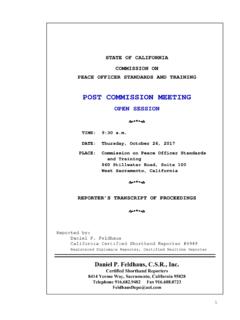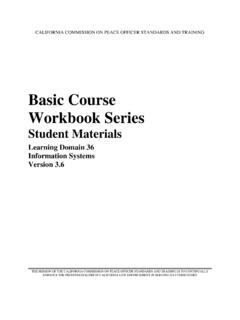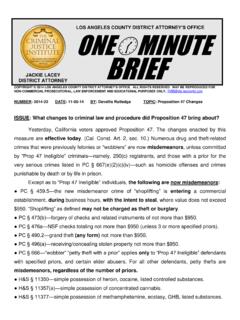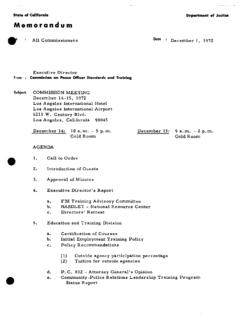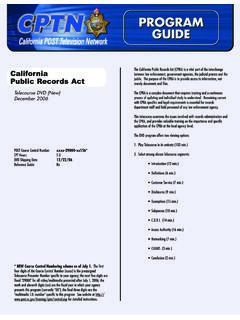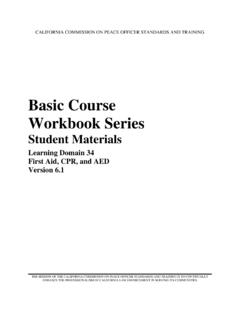Transcription of Basic Course Workbook Series - California
1 California COMMISSION ON peace OFFICER STANDARDS AND TRAINING Basic Course Workbook Series Student Materials Learning Domain 25 Domestic Violence Version THE MISSION OF THE California COMMISSION ON peace OFFICER STANDARDS AND TRAINING IS TO CONTINUALLY ENHANCE THE PROFESSIONALISM OF California LAW ENFORCEMENT IN SERVING ITS COMMUNITIES Basic Course Workbook Series Student Materials Learning Domain 25 Domestic Violence Version Copyright 2006 California Commission on peace Officer Standards and Training (POST) All rights reserved. Published 1998 Revised June 2001 Revised February 2003 Revised January 2006 Revised January 2009 Correction October 2012 Revised January 2014 Correction June 2015 Revised July 2016 Correction November 2016 Revised June 2019 Revised September 2019 Updated December 2019 This publication may not be reproduced, in whole or in part, in any form or by any means electronic or mechanical or by any information storage and retrieval system now known or hereafter invented, without prior written permission of the California Commission on peace Officer Standards and Training, with the following exception: California law enforcement or dispatch agencies in the POST program, POST-certified training presenters, and presenters and students of the California Basic Course instructional system are allowed to copy this publication for non-commercial use.
2 All other individuals, private businesses and corporations, public and private agencies and colleges, professional associations, and non-POST law enforcement agencies in-state or out-of-state may purchase copies of this publication, at cost, from POST as listed below: From POST s Web Site: Go to Ordering Student Workbooks COMMISSION ON peace OFFICER STANDARDS AND TRAINING COMMISSIONERS Joyce Dudley Chair District Attorney Santa Barbara County Rick Braziel Vice Chair Educator Humboldt State University Alan Barcelona Special Agent California Department of Justice Lai Lai Bui Sergeant Sacramento Police Department Thomas Chaplin Chief Walnut Creek Police Department Barry Donelan Sergeant Oakland Police Department Robert Doyle Sheriff Marin County Geoff Long Public Member John McMahon Sheriff San Bernardino County Jethroe Moore, II Public Member James O Rourke Officer California Highway Patrol Batine Ramirez Sergeant Placer County Sheriff s Department Laurie Smith Sheriff Santa Clara County Walter Vasquez Chief La Mesa Police Department Kevin Gardner Representing Xavier Beccera Attorney General Ex-Officio Member Chief Director of Division of Law Enforcement THE ACADEMY TRAINING MISSION The primary mission of Basic training is to prepare students mentally, morally, and physically to advance into a field training program, assume the responsibilities, and execute the duties of a peace officer in society.
3 FOREWORD The California Commission on peace Officer Standards and Training sincerely appreciates the efforts of the many curriculum consultants, academy instructors, directors and coordinators who contributed to the development of this Workbook . We must also thank the California law enforcement agency executives who allowed their personnel to participate in the development of these training materials. This student Workbook is part of the POST Basic Course Training System. The Workbook component of this system provides a self-study document for every learning domain in the Basic Course . Each Workbook is intended to be a supplement to, not a substitute for, classroom instruction. The objective of the system is to improve academy student learning and information retention and ultimately contribute to you becoming a peace officer committed to safety, and to the communities you will serve. The content of each Workbook is organized into sequenced learning modules to meet requirements as prescribed both by California law and the POST Training and Testing Specifications for the Basic Course .
4 It is our hope that the collective wisdom and experience of all who contributed to this Workbook will help you, the student, to successfully complete the Basic Course and to enjoy a safe and rewarding career as a peace officer. MANUEL ALVAREZ, Jr. Executive Director LD 25: Domestic Violence i LD 25: Domestic Violence Table of Contents Topic See Page Preface Introduction How to Use the Student Workbook iii iii iv Chapter 1: Identifying and Classifying Crimes Related to Domestic Violence Overview Defining Domestic Violence Willful Infliction of Corporal Injury Criminal Threats Stalking Malicious Destruction of Telephone, Telegraph, Cable Television, or Electrical Lines Preventing or Dissuading a Witness/Victim from Testifying Battery as Applied to Domestic Violence Spousal Rape Other Crimes That May Relate to Domestic Violence Chapter Synopsis Workbook Learning Activities 1-1 1-1 1-3 1-7 1-9 1-12 1-16 1-18 1-19 1-23 1-25 1-30 1-32 Chapter 2.
5 Impact of Domestic Violence Overview Batterer and Victim Characteristics peace Officer s Role Chapter Synopsis Workbook Learning Activities 2-1 2-1 2-3 2-11 2-13 2-14 Continued on next page Table of Contents, Continued ii LD 25: Domestic Violence Topic See Page Chapter 3: Responding to a Call Overview Response Procedures Arrest of a Batterer Identifying Evidence Victim Protection Chapter Synopsis Workbook Learning Activities 3-1 3-1 3-3 3-11 3-18 3-20 3-22 3-23 Chapter 4: Court Orders Overview Types of Court Orders Validity of Restraining Orders Emergency Protective Orders Enforcement Procedures Chapter Synopsis Workbook Learning Activities 4-1 4-1 4-3 4-7 4-10 4-14 4-18 4-19 Chapter 5: Documenting the Crime Overview Report Documentation Support Services for Victims Chapter Synopsis Workbook Learning Activities 5-1 5-1 5-2 5-6 5-10 5-11 Supplementary Material S-1 Glossary G-1 LD 25: Domestic Violence iii How to Use the Student Workbook Introduction This Workbook provides an introduction to the training requirements for this Learning Domain.
6 It is intended to be used in several ways: for initial learning prior to classroom attendance, for test preparation, and for remedial training. Workbook format To use the Workbook most effectively, follow the steps listed below. Step Action 1 Read the first two sections: Preface and How to Use the Workbook , which provide an overview of how the Workbook fits into the POST Instructional System and how it should be used. 2 Refer to the overview section at the start of each chapter to review the learning objectives. 3 Read the text. 4 Refer to the Chapter Synopsis section at the end of each chapter to review the key points that support the chapter objectives. 5 Complete the Workbook Learning Activities at the end of each chapter. These activities reinforce the material taught in the chapter. 6 Refer to the Glossary section for a definition of important terms. The terms appear throughout the text and are bolded and underlined the first time they appear ( , term).
7 Iv LD 25: Domestic Violence Preface Introduction Student workbooks The student workbooks are part of the POST Basic Course Instructional System. This system is designed to provide students with a self-study document to be used in preparation for classroom training. Regular Basic Course training requirement Completion of the Regular Basic Course is required, prior to exercising peace officer powers, as recognized in the California Penal Code and where the POST-required standard is the POST Regular Basic Course . Student Workbook elements The following elements are included in each Workbook : chapter contents including a synopsis of key points supplementary material a glossary of terms used in this Workbook LD 25: Chapter 1 Identifying and Classifying Crimes Related to Domestic Violence 1-1 Chapter 1 Identifying and Classifying Crimes Related to Domestic Violence Overview Learning need To effectively carry out their responsibilities, peace officers need a Basic knowledge of legal definitions, terminology and applicable penal code sections as well as an understanding of how to classify the crimes that may lead to arrests.
8 Learning objectives The chart below identifies the student learning objectives for this chapter. After completing study of this chapter, the student will be able to: Objective ID Recall the definition of domestic violence (Penal Code Section 13700). Recognize the crime elements required to arrest for the following crimes as applied to domestic violence incidents: - Willful infliction of corporal injury - Battery - Stalking - Malicious destruction of telephone, telegraph, cable television, or electrical lines - Preventing or dissuading a witness or a victim from testifying - Criminal threats - Spousal rape Continued on next page Overview, Continued 1-2 LD 25: Chapter 1 Identifying and Classifying Crimes Related to Domestic Violence Learning objectives (continued) After completing study of this chapter, the student will be able to: Objective ID Recognize the crime classification for each crime that may result from a domestic violence incident as a misdemeanor or felony.
9 In this chapter This chapter focuses on identifying and classifying criminal behavior associated with domestic violence abuse. Refer to the chart below for specific topics. Topic See Page Defining Domestic Violence 1-3 Willful Infliction of Corporal Injury 1-7 Criminal Threats 1-9 Stalking 1-12 Malicious Destruction of Telephone, Telegraph, Cable Television, or Electric Lines 1-16 Preventing or Dissuading a Witness/Victim from Testifying 1-18 Battery 1-19 Spousal Rape 1-23 Other Crimes That May Relate to Domestic Violence 1-25 Chapter Synopsis 1-30 Workbook Learning Activities 1-32 LD 25: Chapter 1 Identifying and Classifying Crimes Related to Domestic Violence 1-3 Defining Domestic Violence Introduction Since 1984, the Legislature has systematically increased law enforcement s responsibility to intervene, resolve, and document incidents of domestic violence (Penal Code Section 13700). To effectively perform these tasks, the peace officer needs to be able to recognize domestic violence and apply the appropriate laws.
10 Leadership In a domestic violence incident, the immediate safety of the victim and children is our primary concern. After safety is ensured, it is the responsibility of the peace officer to provide referrals for a long-term solution. Effective communication demonstrates trust and respect for all individuals involved. Thorough investigation and documentation greatly increase the chances for successful prosecution. Victims of domestic violence need outside support if they are to get out of the relationship and end the abuse. peace officers can provide some of this support through intervention and referral. Definition domestic violence Domestic violence means abuse committed against an adult or a minor (Penal Code Section 13700(b)). This include(s) one or more of the following relationships: spouse/former spouse cohabitant/former cohabitant dating relationship/former dating relationship engagement relationship/ former engagement relationship person with whom the respondent has had a child NOTE: There is no time limit on how long ago the relationship existed.
